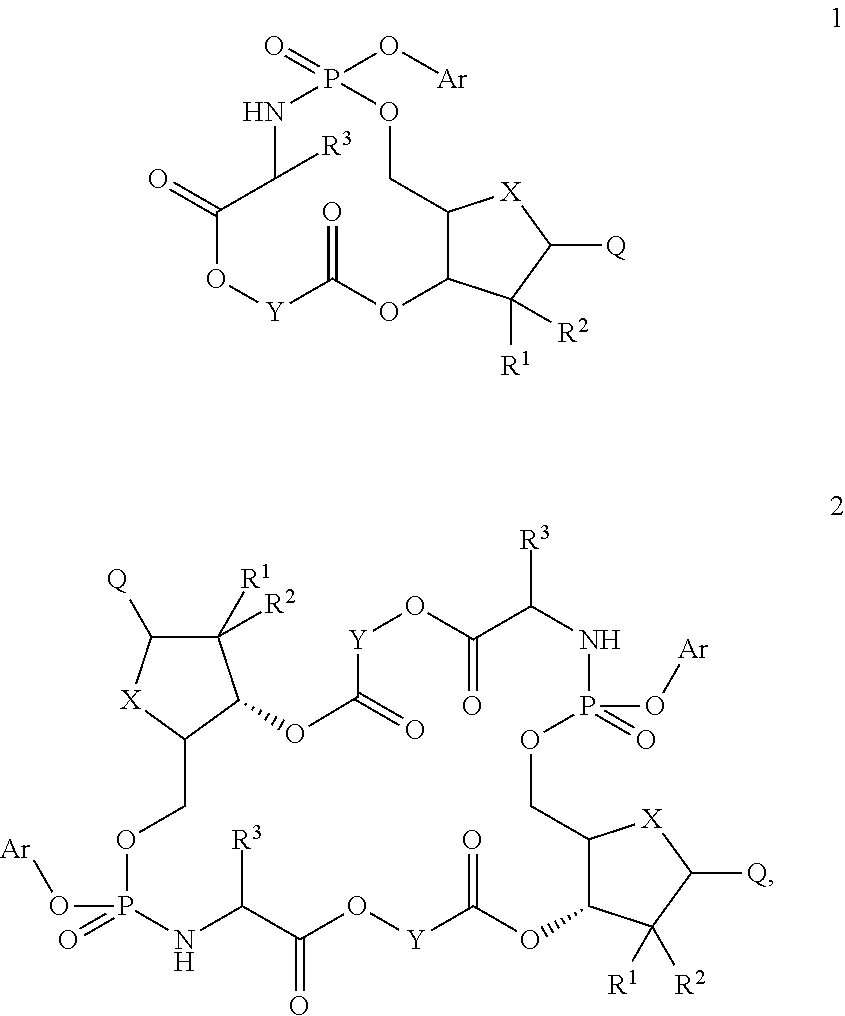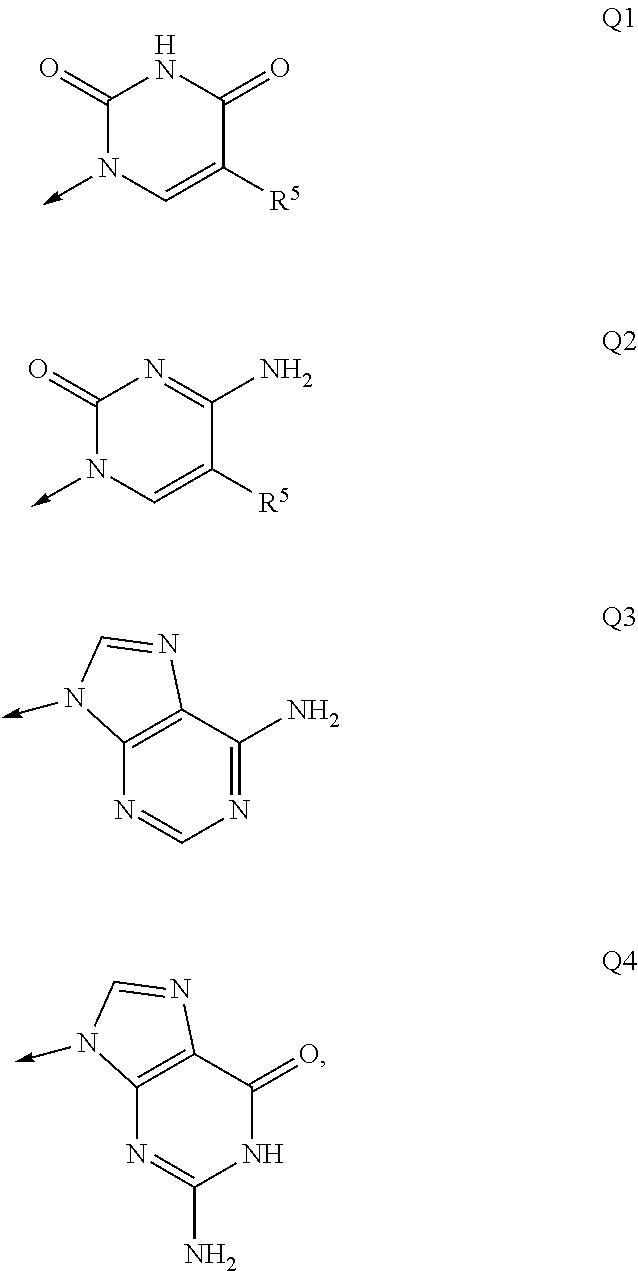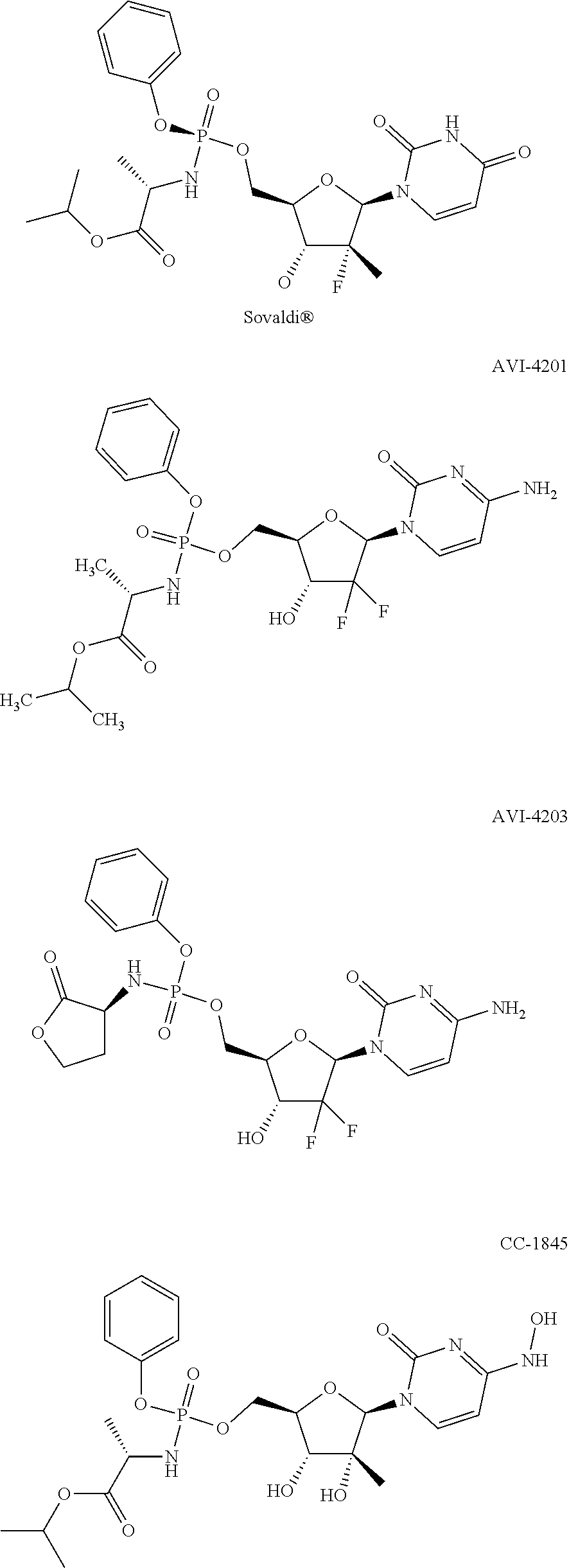Macroheterocyclic nucleoside derivatives and their analogues, production and use thereof
a technology of macroheterocyclic nucleoside and derivatives, applied in the field of macroheterocyclic nucleoside derivatives and their analogues, production, can solve the problems of discontinuation of development of both compounds, and achieve the effect of slowing down absorption
- Summary
- Abstract
- Description
- Claims
- Application Information
AI Technical Summary
Benefits of technology
Problems solved by technology
Method used
Image
Examples
example 1
General Procedure for Preparing Tert-Butoxycarbonylamino)-Propanoates 6a-g
[0106]
[0107]To a solution 2.606 g (14.5 mmol) of benzyl L-lactate (4) and 2.764 g (14.6 mmol) of N-Boc-1-alanine (5a) in 100 ml of DCM at 0° C. were added DMAP (0.353 g, 2.9 mmol) and DCC (3.044 g, 14.7 mmol). The reaction was stirred for 15 h at rt and filtered. The precipitate was washed with ether, the combined filtrate was rotovapped and purified by column chromatography on silica gel (hexane: EtOAc 4:1) to give 4.7 g (92%) of 5)-((S)-1-(benzyloxy)-1-oxopropan-2-yl) 2-(tert-butoxycarbonylamino)propanoate (6a) as a viscous colorless oil. 1H NMR (DMSO-d6, 400 MHz) δ: 7.36 (m, 6H), 5.15 (s, 2H), 5.12 (m, 1H), 4.04 (m, 1H), 1.43 (d, J=7.2 Hz, 3H), 1.37 (s, 9H), 1.23 (t, J=7.2 Hz, 3H).
[0108]Similarly prepared were: (S)-3-(benzyloxy)-3-oxopropyl 2-(tert-butoxycarbonylamino)propanoate (6b)—yield 97%, 1H NMR (DMSO-d6, 400 MHz) δ: 7.36 (m, 5H), 7.24 (d, J=7.6 Hz, 1H), 5.12 (s, 2H), 4.32 (p, J=6.0 Hz, 1H), 4.22 (p, ...
example 2
General Procedure for Preparing 2-aminopropanoate Hydrochlorides 7a-g
[0109]
[0110]To a solution 4.7 g (13.4 mmol) of (5)-((S)-1-(benzyloxy)-1-oxopropan-2-yl) 2-(tert-butoxycarbonylamino)propanoate (6a) in 40 ml of dioxane 40 ml of 3N HCl in dioxane was added. The solution was stirred for 15 h at rt and rotovapped to afford (S)—((S)-1-(benzyloxy)-1-oxopropan-2-yl) 2-aminopropanoate hydrochloride (7a) quantitatively as a viscous colorless oil which slowly crystallized. LC-MS (ESI) 252 (M+H)+, 1H NMR (DMSO-d6, 400 MHz) δ: 8.63 (brs, 3H), 7.38(m, 5H), 5.26(q, J=7.2 Hz, 1H), 5.19 (m, 2H), 4.15(q, J=7.2 Hz, 1H), 1.48(d, J=7.2 Hz, 3H), 1.42 (d, J=7.2 Hz, 3H).
[0111]Similarly prepared were: (S)-3-(benzyloxy)-3-oxopropyl 2-aminopropanoate hydrochloride (7b)—LC-MS (ESI) 252 (M+H)+, 1H NMR (DMSO-d6, 400 MHz) δ: 8.56(brs, 3H), 7.37 (m, 5H), 5.13 (s, 2H), 4.43 (m, 1H), 4.33 (m, 1H), 4.01 (m, 1H), 2.80 (t, J=6.0 Hz, 2H), 1.34 (d, J=7.2 Hz, 3H); (S)-benzyl (2-aminopropanoyloxy)butanoate hydrochlorid...
example 3
General Procedure for Preparing 2-chloro(phenoxy)phosphorylamino)-propanoates 8a-g
[0112]
[0113]A solution 3.035 g (10.5 mmol) of (S)—((S)-1-(benzyloxy)-1-oxopropan-2-yl) 2-aminopropanoate hydrochloride (7a) and phenyl dichlorophosphate (1.575 ml, 10.5 mmol) were dissolved in 40 ml of DCM and cooled to −78 ° C. A solution of triethylamine (2.86 mL, 21 mmol) in 10 mL of DCM was added dropwise and the resulted mixture was stirred at −78 ° C. for 1 h and then allowed to warm up to rt. The mixture was rotovapped and the residue was treated with benzene. The precipitate was filtered off and the filtrate was subjected to dry flash chromatography on dry silica gel (washed with MeCN, EtOAc, toluene, hexane) eluting with hexane: EtOAc 2:1 to give 3.8 g (85%) of S)—((S)-1-(benzyloxy)-1-oxopropan-2-yl) 2-(chloro(phenoxy)phosphorylamino)propanoate (8a) as a colourless oil. 1H NMR (CDCl3, 400 MHz) δ 7.37 (m, 7H), 7.27 (m, 3H), 5.24 (m, 1H), 5.19 (m, 2H), 4.25 (m, 2H), 1.55 (m, 6H).
[0114]Similarly ...
PUM
| Property | Measurement | Unit |
|---|---|---|
| time | aaaaa | aaaaa |
| volume | aaaaa | aaaaa |
| volume | aaaaa | aaaaa |
Abstract
Description
Claims
Application Information
 Login to View More
Login to View More - R&D
- Intellectual Property
- Life Sciences
- Materials
- Tech Scout
- Unparalleled Data Quality
- Higher Quality Content
- 60% Fewer Hallucinations
Browse by: Latest US Patents, China's latest patents, Technical Efficacy Thesaurus, Application Domain, Technology Topic, Popular Technical Reports.
© 2025 PatSnap. All rights reserved.Legal|Privacy policy|Modern Slavery Act Transparency Statement|Sitemap|About US| Contact US: help@patsnap.com



